Definition
Import indexes are an estimation of aggregate price changes from a base year. The Bureau of Labor Statistics sets the base year 2000 as 100. The other changes that exceed the value indicate increases above the year 2000 price aggregate. International Labour Office et al. (2009) define the price index as “a value ratio about two periods that measures the overall changes in prices between the two periods” (p. 358). The indexes measure the changes in aggregate prices that have occurred relative to the base year.
A 10-year analysis of significant changes
The Bureau of Labor Statistics (BLS) offers monthly indexes to changes in aggregate import prices. According to BLS (2014), import indexes increased from January 2003 towards June 2008 (see Appendix A). The values show combinations of increases and decrease a few months towards the end of 2008.
The annual trend shows a decline in 2009 (see Graph 1). In 2010, the values again resumed their steady incremental trend. There was a combination of increases and decreases between 2011 and 2012. In 2013, the values declined almost steadily from 140.1 in January to 137.9 in December (see Appendix A).
The indexes are expected to increase gradually because most countries have an annual inflation rate above 1%. It only becomes unusual when the values decrease. The rapid rise in 2007-2008 could have been caused by the credit boom in the U.S. before the financial crisis immediately after the boom.
The financial crisis resulted in a lower demand for goods and services. Financial institutions were restricting credit to only those with stable cash flows. Unemployment rates were higher, which reduced aggregate demand. Companies were eager to regain the same level of revenue that they had before the crisis. It became necessary to lower prices to maintain the desired revenue levels.
Exchange rates may cause changes in the import indexes. The 2013 decline could have been caused by changes in exchange rates (see Appendix B). Appreciation makes imports cheaper. According to Appendix C, the USD depreciated against major currencies. The graphs in Appendix C show that the USD depreciated against the Chinese yen, British pounds, Indian Rupee, and the Euro.
It goes against the expected trend where the depreciation of the USD is supposed to cause an increase in the import indexes. It shows that the decline in indexes was caused by another factor. It is likely a decrease in demand for imports, which could have caused a decline in demand for foreign exchange.
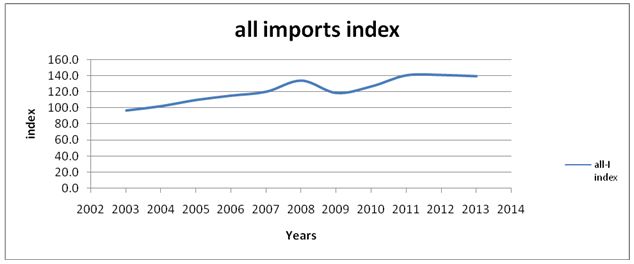
The table below indicates that annual average values declined from the previous year in 2009, and 2013. All other annual averages are incremental from the previous year. The indicator is leading when it causes importers to purchase commodities sooner than expected when they anticipate the USD to depreciate. It is lagging when it causes importers to wait for the dollar to appreciate before they import commodities. For example, towards the end of 2013, it was a leading period for importers because the USD was depreciating further (see Appendix C).
Table 1
Conflicts relative to the indicator
Conflicts may arise from the transfer prices that firms use when they transfer commodities to their subsidiaries. Most countries have taxes on international transactions (Internal Labour Office et al. 2009). Firms would like to use low prices to reduce the amount of tax. The Internal Revenue Service requires that firms use the market prices, which would require that their values match the import index.
Conflict may also arise from one country, depreciating its currency to gain competitiveness (Dridi & Zieschang, 2002). In the past few years, China has been accused of depreciating its currency so that it does not appreciate following the large capital inflows and an increase in exports.
Impact on the national economy and other key indicators
The import indexes are used to examine the terms of trade. Terms of trade are favorable when import prices do not increase more than export prices. Higher import prices create a challenge in the balance of payments account.
The economy would need more exports to balance its accounts (COPAFS, n.d.). Lower import prices would result in more demand for imported commodities than domestic commodities. International Labour Office et al. (2009) discusses that the terms of trade can be examined by dividing the export price index by the import price index.
Table 2
Table 2 shows that the values obtained by dividing the export index and import index have declined steadily except for the year 2008, which is an outlier. The decline in the value indicates that imports are becoming more expensive than exports. It is favorable to the economy when it wants to reduce imports, and increase exports. Lower export prices compared to imports creates a demand for local products, which creates additional employment.
Import price indexes are used to deflate the price of products used to calculate the national income (Dridi & Zieschang, 2002). International Labour Office et al. (2009) explain that “a series of volume measures used in GDP requires deflators of the nominal value” (p. 462). Calculating GDP requires that the effect of inflation to be removed from imported commodities before it is included in the GDP summation.
The Federal Reserve has the mandate to control inflation. Import indexes are used to determine the impact of imports on inflation (COPAFS, n.d.). Import prices affect inflation through their impact on capital goods and consumer goods (Dridi & Zieschang, 2002). The Federal Reserve would want to know the inflation that they cannot control when it is derived from imported goods. Dridi & Zieschang (2002) discuss that the indexes are used to determine pass-through rates emerging from changes in the exchange rates. Pass-through rates are changes in the price index derived directly from the changes in the exchange rate. The fluctuations are not caused by suppliers.
The import indexes are used by the government to predict revenue that may be generated through custom levies. Dridi & Zieschang (2002) discuss that governments use the sources of their revenues when negotiating to finance a budget deficit. Custom tax is among the sources of revenues that the government may need.
The import indexes are used by the private sector to make contracts that will last for a long period. Dridi & Zieschang (2002) explain that parties under the agreement would want to know whether the price would cover the volume of commodities in the long run.
Professional or personal tie to the indicator
The import indexes affect the prices of goods and services that rely on imported commodities. Automobiles, electronics, foods, and beverages are common groups of goods that are affected by import prices. On a personal point of view, I would like to know if import prices on vehicles and automotive parts have remained the same. The industry is very competitive globally. Major producers in the U.S., India, South Korea, Japan, and China engage in competitive pricing.
I try to find out if prices have increased in a similar trend to that of all import commodities against the competitiveness of the industry. Major commodities changed by a margin of 42.6 between 2003 and 2013, the automobile industry changed by a 13.3 margin (see Appendix D). It shows that the competitiveness of the industry makes prices to increase at a lower rate than the aggregate of all imports.
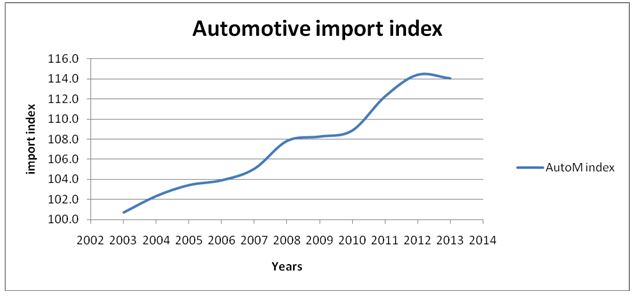
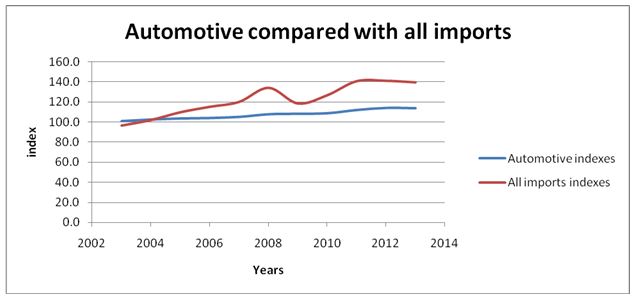
I would also like to know the impact on indexes when petroleum is excluded. I found out that the change in import indexes between 2003 and 2013 is 18.4, which is lower than 42.6 for all commodities (see Appendix E). It shows that petroleum has a larger impact on the increase in import indexes than other commodities.
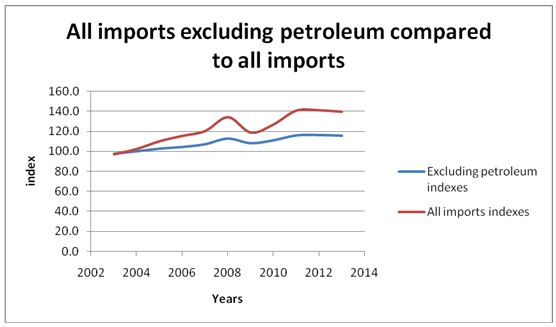
Conclusion
The U.S. import indexes decreased in 2009 and 2013 based on average annual indexes. The likely cause of the change in 2009 is the global financial crisis that occurred at the end of 2008. The likely cause of the 2013 decline in import indexes is low demand for imports. The price index shows a sign of increasing in 2014 based on the first-month data.
The competitiveness in the automotive vehicle, parts and engine industry has resulted in lower increases than the prices of all import commodities. Excluding petroleum from the all import indexes, one notices that petroleum has a major impact on increasing import indexes.
References
BLS. (2014). Import/ Export price indexes: percent change analysis listing for all import commodities. Web.
COPAFS. Get to know a principal economic indicator: U.S. import and export price indexes. Web.
Dridi, J., & Zieschang, K. (2002). Compiling and using export and import price indices, issues 2002-2230. Washington, D.C.: International Monetary Fund.
International Labour Office et al. (2009). Export and import price index manual: theory and practice. Washington, D.C.: International Monetary Fund.
Appendices
Appendix A
Import indexes for all import commodities
Source: BLS (2014).
Appendix B
Source: Rates FX. (2014). US dollar, Wednesday, March 5 2014, 16:15 EST (2014-03- 05 21:15 UTC). Web.
Appendix C
Graphs of major currencies in between Mar 7 and Dec 31, 2013 (1 USD against foreign currencies)
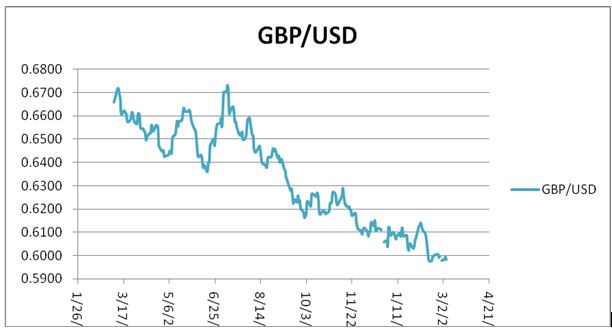
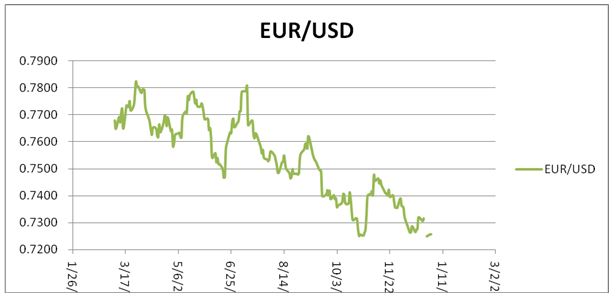
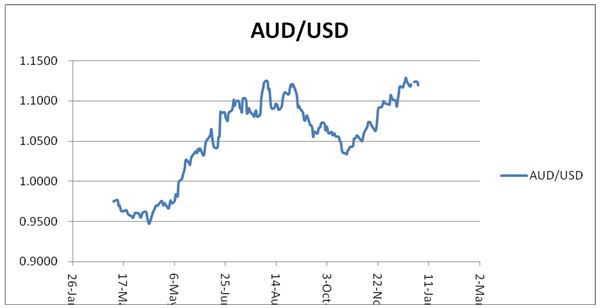


Source of data: Rates FX (2014). Create exchange rate chart and retrieve historical exchange rate data. Web.
Appendix D
Source: BLS (2014).
Appendix E
Source: BLS (2014).